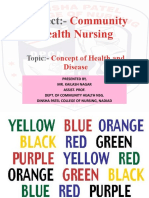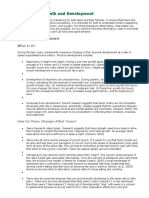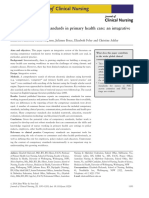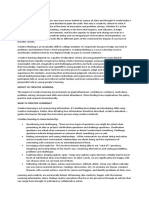100%(1)100% found this document useful (1 vote)
96 viewsUnit - VIII Communication and Utilization of Research Utilization of Research
The document discusses communication and utilization of nursing research. It outlines the importance of effectively communicating research findings through written reports, oral presentations and publications. Key aspects of writing research reports such as format, characteristics, steps and critical review are explained. Barriers to research utilization like lack of time and understanding of importance are highlighted. Strategies to facilitate utilization involving nurse educators, researchers, administrators and clinicians are proposed.
Uploaded by
Sanchita MandalCopyright
© © All Rights Reserved
Available Formats
Download as PDF, TXT or read online on Scribd
100%(1)100% found this document useful (1 vote)
96 viewsUnit - VIII Communication and Utilization of Research Utilization of Research
The document discusses communication and utilization of nursing research. It outlines the importance of effectively communicating research findings through written reports, oral presentations and publications. Key aspects of writing research reports such as format, characteristics, steps and critical review are explained. Barriers to research utilization like lack of time and understanding of importance are highlighted. Strategies to facilitate utilization involving nurse educators, researchers, administrators and clinicians are proposed.
Uploaded by
Sanchita MandalCopyright
© © All Rights Reserved
Available Formats
Download as PDF, TXT or read online on Scribd
You are on page 1/ 21
Unit – VIII
COMMUNICATION AND
UTILIZATION OF RESEARCH
Mrs. S. Andal, M.Sc(N).,
Professor cum Research Co-ordinator
Faculty of Nursing
COMMUNICATION AND
UTILIZATION OF RESEARCH
• A research project cannot be considered
complete until its results are effectively
communicated to its users or consumers.
Therefore communication of research finding is
one of the essential and final steps of research
process.
Purpose for effective communication
• Promotion of learning of new knowledge among
professionals
• Expansion of the base for the evidence based
practice
• Improving the health care outcome by refining the
existing body of professional knowledge
Criteria for Communicating Research
• Selecting proper channel for communicating
• Knowing the consumers
• Developing an effective plan for writing a research
report
• Careful selection of a journal for publication of report
• Careful review of authors manuscript guidelines
Methods of communication
• Written report: published in journals,
publication
• Oral report: presented in conferences
Writing a research report:
• It has ultimate outcome of research process.
The research task is not completed until the
report has been written. Dissemination of
research finding serves scientific, professional
and public functions.
Characteristics:
• A research report must have characteristics of
conciseness, clarity, honesty, completeness and
accuracy.
• It must cover all subjects and maintain interest
among users
• It must be written and presented logically
• Presentation must be visually attractive
• Report must reflect its originality
Steps in writing report
• Logical analysis of subject matter
• Preparation of final outline
• Preparation of rough draft
• Rewriting and polishing rough draft
• Preparation of final bibliography
• Writing the final draft
Format of research report:
• Quantitative research reports typically
follow a conventional format referred to as
IMRAD format. It involves the organization of
the study material in four sections
• Introduction,
• Methods,
• Results and
• Discussion.
1.Introduction
– Background of study
– Need of study
– Research problem
– Objectives
– Hypothesis
– Assumptions
– Operational Definitions
– Conceptual Framework
– Literature Review
2.Methods
– Research Design
– Research Setting
– Target Population
– Sampling Technique and Size
– Development & Description of Data Collection Tools
– Validity and Reliability of Tools
– Methods of Data Collection
– Pilot Study
– Ethical consideration
– Plan for data analysis
3.Results
It is the heart of a research report. Both
descriptive and inferential statistics have
been used to test the preset hypotheses
and inferences after the rejection or
acceptance of the hypotheses.
4.Discussion
It must be written in a logical sequence,
where synthesis and interpretation of
results are made in light of limitations of
the study to avoid the publication bias
and reporting bias.
Critical Review of Research Work
• Research critique is a planned, careful
critical evaluation of a piece of research work
against the pre specified criteria to judge the
strengths and weakness of research study.
• A research critique reflects a penetrating
analysis of a study in which judicious and
constructive comments have been made about
a piece of work. [Leininger 1968]
Purpose:
• To provide inputs regarding the strengths &
weakness of a study.
• To provide suggestions about methodological
flaws to the students.
• To evaluate understanding of research by the
students.
• To judge scientific merits of the study.
• To take decision whether to publish the study in
journal or not.
Guidelines:
• Read and understand the research report
carefully
• Carryout critical appraisal of all the aspects of
research reports
• Avoid general vague statements
• Be objective and sensitive while framing
negative comments
• Keep balanced approach by presenting both
strong and weak point
• Positive and negative commands must be
supported with examples to make clear
Utilization of Nursing Research
• In recent days in nursing the need for research
based practice is still widely accepted but unfortunately
many current nursing interventions are based on
traditions rather than science.
• In today’s cost and time conscious health care
environment nurses cannot afford to spend time on
unnecessary or ineffective procedure at a time when
nurses are asked to take care of more complicated
illness and demanding patients striving for decreased
length of stay. The nurse must work smarter and not
harder for this the actual utilization of nursing research
and practice has to be realized.
Barriers in Utilization
• Nurses lack time to actively participate in
conducting and implementing research
• Do not understand the important of research
• It is a minute and difficult component of UG
program
• Our health care scenario pays little attention to
research
• Staff nurses may not read nursing research journals
• Research reports are presented to researcher and
the reports are not reaching to nurses who can
practically use these new ideas.
Strategies in Facilitate Utilization of Nursing
Research
• The most crucial factor in facilitating research
utilization is the identification of clinically relevant
problems and issues.
• The barrier to research based practice are
multidimensional, so the process to implement
effective strategies to overcome these barriers will
require a combined effort from nurses to education,
research, administration and clinical practice.
Nurse Educators:
• Use research finding to support lectures
and teaching
• Incorporate research findings in clinical
assignments
• Motivate students to conduct research activity
Nurse Researchers:
• Focus the research activity on current
clinical problems
• Disseminate research results as early as
possible
• Present research findings locally, regionally
and nationally
• Publish research finding
• Clearly delineate practice implications of
results
Nurse Administrators:
• Establish research friendly culture
• Encourage clinicians to question traditions.
• Reward risk taking and innovation
• Require research basis for practice changes
• Incorporate research role in job
descriptions
• Encourage and support continuing
education
Nurse Clinicians:
• Question practice traditions
• Stay updated with literature
• Commit to continuous learning, such as
continuing education, joining professional
organizations, and pursuing advanced degrees.
• Collaborate with researchers to relay clinical
issues and questions.
• Support research conduct in the clinical setting.
• Take the risks to make changes and improve
practice.
You might also like
- Health Policy and Management Handout 3143No ratings yetHealth Policy and Management Handout 314362 pages
- Activity (Emotional, Social and Spiritual Legacy)67% (9)Activity (Emotional, Social and Spiritual Legacy)2 pages
- Unit-VIII - Communication of Research FindingsNo ratings yetUnit-VIII - Communication of Research Findings37 pages
- Introduction of Public Health in Community PracticeNo ratings yetIntroduction of Public Health in Community Practice23 pages
- Introduction To PH - Lecture 1 - HBIII - 230216 - 073301No ratings yetIntroduction To PH - Lecture 1 - HBIII - 230216 - 07330135 pages
- History of Disease & Levels of Prevention 2No ratings yetHistory of Disease & Levels of Prevention 239 pages
- International Health Regulations (IHR) - Division of Global Health Protection - Global Health - CDCNo ratings yetInternational Health Regulations (IHR) - Division of Global Health Protection - Global Health - CDC5 pages
- Dissertation - Synopsis: Dr. Preethika GB Post Graduate Student Department of Oral Medicine and Radiology100% (1)Dissertation - Synopsis: Dr. Preethika GB Post Graduate Student Department of Oral Medicine and Radiology27 pages
- The Beveridge Model of Social Health InsuranceNo ratings yetThe Beveridge Model of Social Health Insurance32 pages
- Aksum University-Department of Nursing For 3 Yr BSC Nursing StudentsNo ratings yetAksum University-Department of Nursing For 3 Yr BSC Nursing Students21 pages
- Chapter Two: Health Determinants, Measurements, and TrendsNo ratings yetChapter Two: Health Determinants, Measurements, and Trends65 pages
- College Mathematics 1A MAT 1044 Test 1 SAMPLE TESTNo ratings yetCollege Mathematics 1A MAT 1044 Test 1 SAMPLE TEST3 pages
- 07 Nursing Role in The Health of Ill Children and Their FamiliesNo ratings yet07 Nursing Role in The Health of Ill Children and Their Families20 pages
- Chapter 1 Communicable Diseases 2ND Sem 2022 2023No ratings yetChapter 1 Communicable Diseases 2ND Sem 2022 202310 pages
- PHC & Rural Health Hasnat Hussain (Reus-11)No ratings yetPHC & Rural Health Hasnat Hussain (Reus-11)4 pages
- Unit 1 Introduction To Community Health Nursing, Educational PlatformNo ratings yetUnit 1 Introduction To Community Health Nursing, Educational Platform62 pages
- Environment and Health: Medical EntamologyNo ratings yetEnvironment and Health: Medical Entamology26 pages
- Nursing Competency Standards in Primary Health Care - An IntegrativeNo ratings yetNursing Competency Standards in Primary Health Care - An Integrative13 pages
- Lecture Note Introduction to Public Health 20242025No ratings yetLecture Note Introduction to Public Health 2024202526 pages
- Public Health Legislation and Administration100% (1)Public Health Legislation and Administration7 pages
- Institutional Review Committee (IRC) : Ethical Approval Research Proposal FormatNo ratings yetInstitutional Review Committee (IRC) : Ethical Approval Research Proposal Format11 pages
- Unit 22: Research Methodology For Health and Social CareNo ratings yetUnit 22: Research Methodology For Health and Social Care12 pages
- Exam Paper - Foundations of Public Health - FinalNo ratings yetExam Paper - Foundations of Public Health - Final10 pages
- Pre Professional Examination For General Nurses MCQNo ratings yetPre Professional Examination For General Nurses MCQ29 pages
- INTRODUCTION TO CHN -BASIC CONCEPTS_043225100% (1)INTRODUCTION TO CHN -BASIC CONCEPTS_043225120 pages
- 12 Presentation Discussion and Utilization of FindingsNo ratings yet12 Presentation Discussion and Utilization of Findings33 pages
- Eckhart Tolle On The Dark Night of The SoulNo ratings yetEckhart Tolle On The Dark Night of The Soul2 pages
- Closing Arguments - Global Arbitration ReviewNo ratings yetClosing Arguments - Global Arbitration Review10 pages
- Reskilling and Upskilling of Teachers in Math Nov 11 2022No ratings yetReskilling and Upskilling of Teachers in Math Nov 11 202263 pages
- My Score in Study Habits Questionnaire Aspect of Study Habits My Score InterpretationNo ratings yetMy Score in Study Habits Questionnaire Aspect of Study Habits My Score Interpretation1 page
- Introduction To IC in Business PoliticsNo ratings yetIntroduction To IC in Business Politics24 pages
- ENGLISH DEPARTMENT SUPERVISORY-PLAN-march-2022No ratings yetENGLISH DEPARTMENT SUPERVISORY-PLAN-march-20224 pages
- Philo Module 1 The Meaning and Method of Doing Philosophy100% (1)Philo Module 1 The Meaning and Method of Doing Philosophy17 pages
- MN1520-2 in Class Assignment Test 1 Review Guidelines (29!09!2020)No ratings yetMN1520-2 in Class Assignment Test 1 Review Guidelines (29!09!2020)2 pages
- THBT Children Should Only Get Pocket Money If They Do Their ChoresNo ratings yetTHBT Children Should Only Get Pocket Money If They Do Their Chores1 page
- Introduction of Public Health in Community PracticeIntroduction of Public Health in Community Practice
- Introduction To PH - Lecture 1 - HBIII - 230216 - 073301Introduction To PH - Lecture 1 - HBIII - 230216 - 073301
- International Health Regulations (IHR) - Division of Global Health Protection - Global Health - CDCInternational Health Regulations (IHR) - Division of Global Health Protection - Global Health - CDC
- Dissertation - Synopsis: Dr. Preethika GB Post Graduate Student Department of Oral Medicine and RadiologyDissertation - Synopsis: Dr. Preethika GB Post Graduate Student Department of Oral Medicine and Radiology
- Aksum University-Department of Nursing For 3 Yr BSC Nursing StudentsAksum University-Department of Nursing For 3 Yr BSC Nursing Students
- Chapter Two: Health Determinants, Measurements, and TrendsChapter Two: Health Determinants, Measurements, and Trends
- College Mathematics 1A MAT 1044 Test 1 SAMPLE TESTCollege Mathematics 1A MAT 1044 Test 1 SAMPLE TEST
- 07 Nursing Role in The Health of Ill Children and Their Families07 Nursing Role in The Health of Ill Children and Their Families
- Unit 1 Introduction To Community Health Nursing, Educational PlatformUnit 1 Introduction To Community Health Nursing, Educational Platform
- Nursing Competency Standards in Primary Health Care - An IntegrativeNursing Competency Standards in Primary Health Care - An Integrative
- Lecture Note Introduction to Public Health 20242025Lecture Note Introduction to Public Health 20242025
- Institutional Review Committee (IRC) : Ethical Approval Research Proposal FormatInstitutional Review Committee (IRC) : Ethical Approval Research Proposal Format
- Unit 22: Research Methodology For Health and Social CareUnit 22: Research Methodology For Health and Social Care
- Pre Professional Examination For General Nurses MCQPre Professional Examination For General Nurses MCQ
- 12 Presentation Discussion and Utilization of Findings12 Presentation Discussion and Utilization of Findings
- Reskilling and Upskilling of Teachers in Math Nov 11 2022Reskilling and Upskilling of Teachers in Math Nov 11 2022
- My Score in Study Habits Questionnaire Aspect of Study Habits My Score InterpretationMy Score in Study Habits Questionnaire Aspect of Study Habits My Score Interpretation
- Philo Module 1 The Meaning and Method of Doing PhilosophyPhilo Module 1 The Meaning and Method of Doing Philosophy
- MN1520-2 in Class Assignment Test 1 Review Guidelines (29!09!2020)MN1520-2 in Class Assignment Test 1 Review Guidelines (29!09!2020)
- THBT Children Should Only Get Pocket Money If They Do Their ChoresTHBT Children Should Only Get Pocket Money If They Do Their Chores

























































































